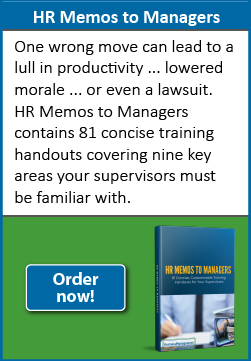A practical guide to terminating an employee with a disability
 Are you thinking of firing an employee who has a disability? You want to be sure you’re not violating the rights the American Disabilities Act has granted them. With more than 42 million Americans with disabilities in the workforce, you are likely to find yourself in this position at some point.
Are you thinking of firing an employee who has a disability? You want to be sure you’re not violating the rights the American Disabilities Act has granted them. With more than 42 million Americans with disabilities in the workforce, you are likely to find yourself in this position at some point.
While some believe it’s impossible to fire a disabled employee, that isn’t true. You have to ensure you’re not in violation of the laws put in place to protect them from being discriminated against solely because of their disability.
What is the Americans with Disabilities Act?
First, you want to ensure you’re clear about the protections afforded to people with disabilities by the Americans with Disabilities Act (ADA).
The Americans with Disabilities Act became law in 1990 and is a civil rights law that protected disabled people from discrimination in various areas of life, including work, transportation, school, and the general public.
The ultimate purpose is to ensure that those with disabilities have the same rights, protections, and opportunities as those without diagnosed disabilities.
Then in 2009, the Americans with Disabilities Act Amendments Act (ADAAA) became law which altered the way we use the term disability to be more inclusive.
Title 1 of the ADA – the Equal Employment Opportunity for Individuals with Disabilities – helps those with disabilities have equal employment opportunities and benefits as those who don’t. It requires employers to provide reasonable accommodations to applicants and employees who are qualified to complete the job. Accommodations are considered reasonable when they allow the applicant or employee to participate in the application process or perform their job duties.
Is your company required to abide by ADA rules and regulations?
Now, it’s essential to determine whether your company is required to follow the ADA rules and regulations.
If your company engages in interstate activity and has 15 or more employees who work at least 20 weeks out of the year, you must abide by these disability discrimination laws. This is enforced by the equal employment opportunity commission (EEOC).
Is the employee disabled under the ADA?
Not all physical, mental, and emotional health conditions, diagnosed officially or not, are covered under the Americans with Disabilities Act.
According to the ADA and ADAAA, a person is disabled when they:
- Have physical or mental impairment that substantially limits one or more major life activities.
- Have record of such an impairment,
- Are regarded as having an impairment whether the impairment limits their major life activities or not
As you determine whether an employee’s disability is protected under the laws, you want to ask yourself the following questions.
Is the condition short-term and temporary?
If so, the disabled employee isn’t covered under the Americans with Disabilities Act. Disabilities that are transitory – for example, lasting for less than 6 months – often don’t qualify.
Is the employee on FMLA?
FMLA or the Family Medical Leave Act protects an employee’s job when they have to take a leave of absence due to serious health conditions such as the birth of a child or military-related leave. Their job is protected for up to 12 weeks for most health conditions.
You want to determine whether the employee’s leave disability leave under FMLA is grounds for termination and how that impacts their protections.
Does the disability restrict the employee from completing part of their job?
To be covered, the disability must restrict the employee from performing various jobs and duties.
Does medical evidence exist to support the claim?
Unless the employee has medical evidence that the disability exists, it can’t be covered under these employment laws. Not only must there be evidence that it exists, but it must limit their life in a significant way.
You also want to request evidence of the disability. Having proof will be helpful in case the employee requires accommodations down the road.
If it’s found that the answers to these questions point to the employee not being covered under the ADA, the employer has the right to terminate the employee as they would any other without fear of repercussion due to violating their rights under the Americans with Disabilities Act.
What essential job functions are not being met?
Once you determine the employee has a covered disability, ensure you’re clear about the essential job functions they’re not completing.
As the employer, you should expect employees with disabilities to perform their essential job functions as other employees do, and you shouldn’t change the expectations due to their disability.
This might require you to look at the initial job posting or internal job description to determine where the employee is lacking.
Did you provide reasonable accommodations?
After reviewing the essential job functions that are not being met, you have to ask yourself whether you’ve provided accommodations to the employee.
You’re required to provide reasonable accommodations to employees with disabilities so they can perform the essential functions of their job. If you fail to provide those accommodations, you are violating their rights.
Keep in mind that accommodations are only required when requested by the employee. The employee doesn’t have to use the term “accommodations” in their request, but it will meet the same purpose. They must simply request that you allow for specific changes to their work environment or processes to succeed.
The accommodations are in place to essentially level the playing field for employees who need additional support to perform their job duties successfully. The expectation isn’t for you to lower or change standards because you hire an employee with a disability, so the accommodations should help fill the gap. Expecting less of your employees with a disability isn’t a reasonable accommodation.
Accommodations also don’t include doing something that would cause undue hardship to the company as a whole, including unreasonable difficulty and expenses or removing an essential job function altogether.
So, as long as you’ve met the requirements for providing reasonable accommodations and the employee still fails to meet the standards, you can move forward in the termination process.
Did you fail to provide accommodations?
If you found that you couldn’t provide accommodations, you want to have this documented to move forward with the employee termination. This isn’t required but is certainly a best practice. Your denial of accommodations should include your decision along with the reasons why you’re unable to fulfill them.
Also, if there was an opportunity to select an accommodation that required less effort on your part while still helping to remove the success barrier, you can provide that. Still, again, the reasoning should be documented.
Do you have documentation regarding your reason for termination?
The best way to ensure you’re firing an employee strictly for their performance, not because of their disability status, is to hold regular evaluations of their job performance. The evaluations should speak to qualitative and quantitative data points and facts supporting your claims about the assessment.
Along with your evaluations, you should also document other occurrences leading up to the termination. For example, if the employee receives reprimands or warnings, be sure to report them. Include important information such as dates, times, places, the violation, the disciplinary action, and even witnesses if they were present.
Did you follow typical termination procedures?
Your company should have a documented procedure for firing employees, and it should be consistent across the board. So you want to ask yourself whether you’ve followed the typical process or if you’re veering away because the employee has a disability.
Can you provide an alternative to termination?
Before terminating an employee, ask yourself whether they would thrive in a different position or a different department. You might determine based on their performance that they’d be better suited elsewhere, and you can recommend them for the job or simply move them if you have the power to do so.
Another option includes simply giving the employee another chance. You should only do this if it’s a company-wide policy, not something solely for those with disabilities because that’s not a reasonable accommodation and can be considered a form of discrimination against employees without a disability.
Are you ready to hold a termination meeting?
Once you determine that termination is the best course of action, you want to consider whether you’re ready for a proper termination meeting to end the relationship.
Here are some tips to keep in mind.
- Provide an explanation. Once you explain that the employee will be terminated, provide a reason why. This might include bringing along recent performance reviews or written warnings, so there’s clarity behind why they’re being fired. Being vague allows for too many questions and is more likely to lead the employee to believe they’re being fired due to their disability instead of their poor performance or other reason.
- Allow time for conversation. Instead of explaining that the employee is fired and ending the meeting, allow for discussion. Understand that the employee likely won’t be happy about the decision and might have questions for you or feelings to express. Be prepared to have the conversation even if it’s uncomfortable.
- Provide next steps. Once you’ve had the termination conversation, you want to provide the next steps so they know what to expect. This might include their final day at work, company property they need to return, and the date of their last paycheck. If you believe the employee would thrive in a different job setting, you might consider providing a letter of recommendation to aid in their future job hunt.
Avoid wrongful termination claims
When you consider the points listed above, you put yourself in a better position to avoid a discrimination lawsuit from an employee who believes they’re a victim of employment discrimination due to their disability. Ultimately, you want to consult with an attorney to ensure you’re following any rules, regulations, and local ordinances properly.






